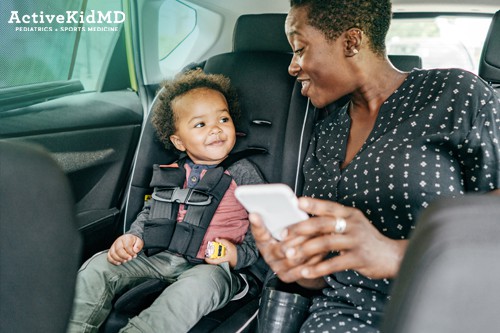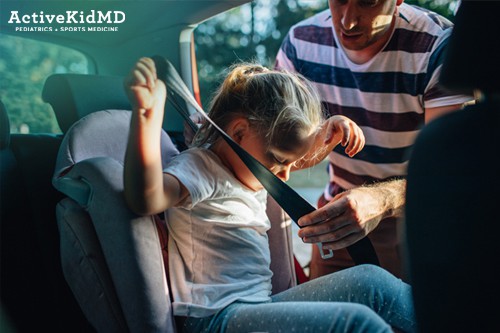We talk a lot about cars in our baby and infant well-child visits. It starts at the very first newborn visit when new parents carry in a relatively big car seat holding a relatively small child. The car discussions continue through the first few years of growth and development.
No, we are not going over the latest makes and models, but rather figuring out the safest ways to get children from one place to another.
Read on to get answers to common questions on babies, toddlers, and car seats.
Some other related topics that new parents may enjoy reading up on include:
- Baby Proofing- The First Year
- Motor Developments in the First Years of Life
- Feeding Infants: Sensible Tips to Make Mealtimes Enjoyable
How hard can it be to install a car seat?
Looking at most installation instructions, finding the back seat upper/lower anchors, then clipping in the car seat base connectors before running the seat belt through the base shouldn’t be a big deal. The reality is not always so simple. It is best not to wait until right before that first drive to check out the car seat placement, but to dedicate some time earlier for that first run at installation.
Newborns/Infants
Newborns will be rear facing in the back seat and directly behind one of the front seats (words to the wise: behind passenger seat is easier for driver to reach back to tend to the child).
Finding the lower anchors can be a chore-especially if they are buried deep into that back seat. You might also have to slide front seats forward for more room to get the seat properly situated. This will also help with getting the child and seat in and out of the car.
Practice getting the car seat in and out of the car. Notice how much room you might need before parking in a tight spot. Words to the wise: throw the baby bag over a shoulder for even more realistic practice. Find out the best technique to smoothly snap the seat into the base to not jostle and awaken a sleeping infant.
If you have more than one car, check fit and placement in each vehicle, again, ahead of time.
Don’t be afraid to use resources such as the local police departments and the American Automobile Association (aka Triple A) help with car seat placement.
 What is the car seat challenge and who needs it?
What is the car seat challenge and who needs it?
Babies born early (usually at or before 37 weeks of gestation) tend to be smaller and may have less control of head, neck and the upper airway. Thus, before leaving the hospital, some premature (or lower birthweight) newborns may have to pass the car seat challenge. The baby is placed in the car seat and breathing/heart rate are monitored. Babies who have issues with low breathing rates, stopping breathing or reduced heart rate are not cleared to be placed in car seats and cannot leave the hospital until passing this challenge.
The Toddler Car Seat
Babies grow quickly, often doubling birth weight by 4-5 months. So, it may be a matter of months when they start to outgrow the infant car seat. There are some published numbers about recommended height or weight, but there is a more practical guideline. Once the infant’s head comes out the top of the car seat, or the legs come out the bottom, then it is time to move up to the toddler size car seat. The larger car seat will still face backward in the back seat. For many otherwise healthy babies, this tends to be around 8-12 months of age.
When does the toddler car seat turn forward?
I tend to get this question at the 18-month well-child visit and again at the 2-year visit. There are a couple ways to answer this question. The first way is to look at any state laws. In my home state of California, children must be rear facing until at least age 2. Next, realize that sitting in a rear facing car seat is safest for all children. So, I tell families that if a child is good with facing backward and not putting up a fight, then keep the car seat backward as long past age 2 as possible. However, if the rear-facing child wants to check out the world and becomes a distraction to the driver, this becomes a unique safety issue and turning the car seat forward may be the best situation for all. Words to the wise: expect first born children to comply more with facing backward, but later born children who want to keep up with older siblings will likely be more interested in facing forward sooner in the game.
 The Booster Seat
The Booster Seat
The most general recommendation on moving your child to a booster seat is between 4-6 years of life. This is a pretty large range and doesn’t consider a child’s individual size and development. Here’s what I think are two practical guidelines of when a child is ready to move into a booster seat (words to the wise: it’s all in the seat belt):
- A child is tall enough that the shoulder belt goes over the shoulder/collar bone and not the neck region
- The lap belt goes over the pelvic bones and not over the soft part of the stomach/abdominal region
Following these guidelines will let the seat belt do the job of holding the child back in the event of an abrupt stop and reduce risk of damage to the less sturdy soft tissue organs (airway stomach, liver, intestines).
A Few Reminders
Just remember that the very best car seat is one that is used correctly.
- Avoid choosing the wrong type of seat for your child’s age and weight. Common car seat mistakes include not installing the seat tightly enough, having loose harness straps and turning children forward-facing too soon.
- Remember to register your car seat so that you will be notified of any car seat recalls.
- Use caution with pickup trucks. Children should never be allowed to ride in the cargo area of a pickup truck. Parents should also be aware that the smaller rear seats of a two, three, and some four-door pickups are not as safe as the larger back seats found in other cars and SUVs. The tight back seat increases the chances of the child’s head and other body parts hitting the back of the front seat in an impact crash.
While there are differences in prices for car seats, all car seats must meet the same federal safety and crash performance standards. When in doubt, check out the National Highway Transportation Association (NHTSA) which provides ease-of-use ratings for car seats.
Dual board-certified pediatric and sports medicine specialists Dr. Chris Koutures offers an individualized approach to general pediatric and sports medicine care that enhances the health and knowledge of patients and their families in Orange County, California. Please contact us at 714-974-2220 or info@activekidmd.com to schedule a visit and become partners in the health of your child.


 What is the car seat challenge and who needs it?
What is the car seat challenge and who needs it? The Booster Seat
The Booster Seat